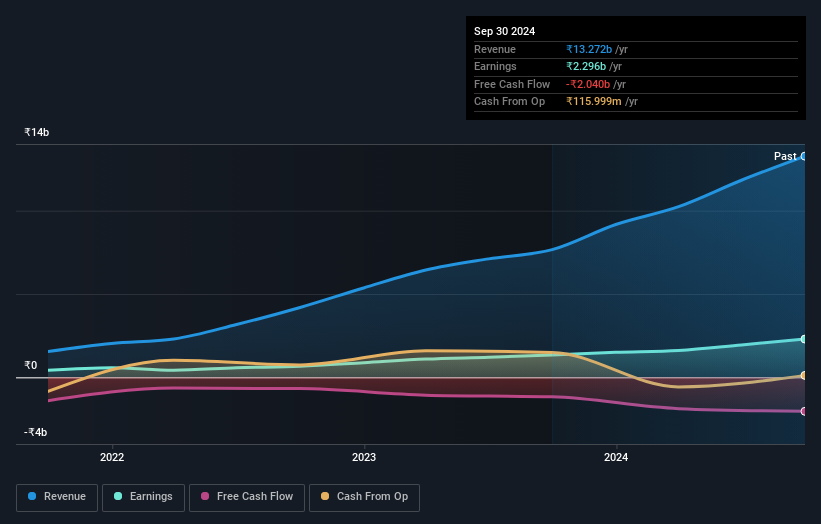- India
- /
- Renewable Energy
- /
- NSEI:KPIGREEN
Insiders have been selling KPI Green Energy Limited (NSE:KPIGREEN) recently yet still hold a significant stake; 16% drop last week not ideal

Key Insights
- Insiders appear to have a vested interest in KPI Green Energy's growth, as seen by their sizeable ownership
- A total of 2 investors have a majority stake in the company with 50% ownership
- Insiders have been selling lately
If you want to know who really controls KPI Green Energy Limited (NSE:KPIGREEN), then you'll have to look at the makeup of its share registry. The group holding the most number of shares in the company, around 54% to be precise, is individual insiders. That is, the group stands to benefit the most if the stock rises (or lose the most if there is a downturn).
Despite recent sales, insiders own the most shares in the company. As a result, they were also the group to endure the biggest losses as the stock fell by 16%.
In the chart below, we zoom in on the different ownership groups of KPI Green Energy.
See our latest analysis for KPI Green Energy

What Does The Institutional Ownership Tell Us About KPI Green Energy?
Many institutions measure their performance against an index that approximates the local market. So they usually pay more attention to companies that are included in major indices.
Less than 5% of KPI Green Energy is held by institutional investors. This suggests that some funds have the company in their sights, but many have not yet bought shares in it. If the business gets stronger from here, we could see a situation where more institutions are keen to buy. It is not uncommon to see a big share price rise if multiple institutional investors are trying to buy into a stock at the same time. So check out the historic earnings trajectory, below, but keep in mind it's the future that counts most.

KPI Green Energy is not owned by hedge funds. Our data suggests that Farukbhai Patel, who is also the company's Top Key Executive, holds the most number of shares at 49%. When an insider holds a sizeable amount of a company's stock, investors consider it as a positive sign because it suggests that insiders are willing to have their wealth tied up in the future of the company. With 1.7% and 1.4% of the shares outstanding respectively, Irfanahmed Mombasawala and The Vanguard Group, Inc. are the second and third largest shareholders.
A more detailed study of the shareholder registry showed us that 2 of the top shareholders have a considerable amount of ownership in the company, via their 50% stake.
While studying institutional ownership for a company can add value to your research, it is also a good practice to research analyst recommendations to get a deeper understand of a stock's expected performance. Our information suggests that there isn't any analyst coverage of the stock, so it is probably little known.
Insider Ownership Of KPI Green Energy
The definition of an insider can differ slightly between different countries, but members of the board of directors always count. The company management answer to the board and the latter should represent the interests of shareholders. Notably, sometimes top-level managers are on the board themselves.
Most consider insider ownership a positive because it can indicate the board is well aligned with other shareholders. However, on some occasions too much power is concentrated within this group.
Our most recent data indicates that insiders own the majority of KPI Green Energy Limited. This means they can collectively make decisions for the company. So they have a ₹38b stake in this ₹69b business. Most would be pleased to see the board is investing alongside them. You may wish todiscover (for free) if they have been buying or selling.
General Public Ownership
The general public-- including retail investors -- own 38% stake in the company, and hence can't easily be ignored. While this size of ownership may not be enough to sway a policy decision in their favour, they can still make a collective impact on company policies.
Next Steps:
While it is well worth considering the different groups that own a company, there are other factors that are even more important. Consider for instance, the ever-present spectre of investment risk. We've identified 2 warning signs with KPI Green Energy (at least 1 which doesn't sit too well with us) , and understanding them should be part of your investment process.
Of course, you might find a fantastic investment by looking elsewhere. So take a peek at this free list of interesting companies.
NB: Figures in this article are calculated using data from the last twelve months, which refer to the 12-month period ending on the last date of the month the financial statement is dated. This may not be consistent with full year annual report figures.
Valuation is complex, but we're here to simplify it.
Discover if KPI Green Energy might be undervalued or overvalued with our detailed analysis, featuring fair value estimates, potential risks, dividends, insider trades, and its financial condition.
Access Free AnalysisHave feedback on this article? Concerned about the content? Get in touch with us directly. Alternatively, email editorial-team (at) simplywallst.com.
This article by Simply Wall St is general in nature. We provide commentary based on historical data and analyst forecasts only using an unbiased methodology and our articles are not intended to be financial advice. It does not constitute a recommendation to buy or sell any stock, and does not take account of your objectives, or your financial situation. We aim to bring you long-term focused analysis driven by fundamental data. Note that our analysis may not factor in the latest price-sensitive company announcements or qualitative material. Simply Wall St has no position in any stocks mentioned.
About NSEI:KPIGREEN
KPI Green Energy
Generates and supplies solar power under Solarism brand name in India.
Solid track record with excellent balance sheet.
Similar Companies
Market Insights
Community Narratives



